Abstract
Thirty mild hypertensives were treated for more than two months with either cardioselective (atenolol or metoprolol) or non-selective (propranolol or pindolol) beta-blockers; the patients were assigned to the drugs in a double-blind manner. A procedure was designed to distinguish between the effects of the drugs themselves while treatment continued, and the development of adaptive changes which would persist when the drugs had been eliminated from the body. Though individual responses to treatment varied in both groups, the mean effect of the cardioselective and non-selective drugs in the control of hypertension was similar. There was no evidence of the development of supersensitivity or "rebound". On the contrary, an adaptive bradycardia (that is a fall of not less than 10% in heart rate persisting 52 hours after stopping treatment) was observed at rest in 17/30 patients, and peak heart rates and blood pressures during exercise were lower in both groups than before treatment. Cardioselective drugs induced a significantly greater bradycardia at rest than non-selective, but on exercise increases in heart rate were reduced more by the non-selective drugs, so that the same peak heart rates were reached on exercise in both groups. Adaptation also affected QT. The results suggest that two factors govern the shortening of QT by increases in heart rate, a "metabolic" effect, determined by sympathetic drive, and a "biophysical" effect determined by heart rate. The adrenergic effect is attenuated by acute beta-blockade, or by adaptation to prolonged blockade, leaving a shallow, rate-determined, slope to the QT/RR regression.
Full text
PDF
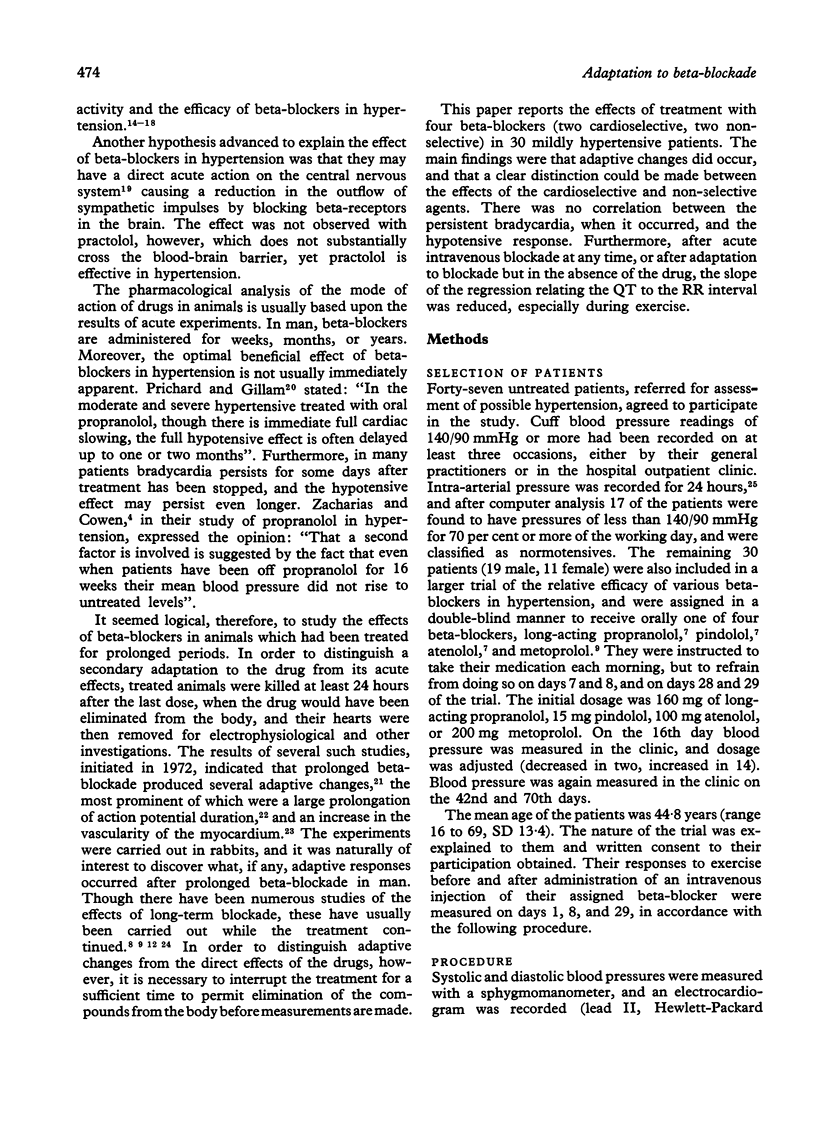

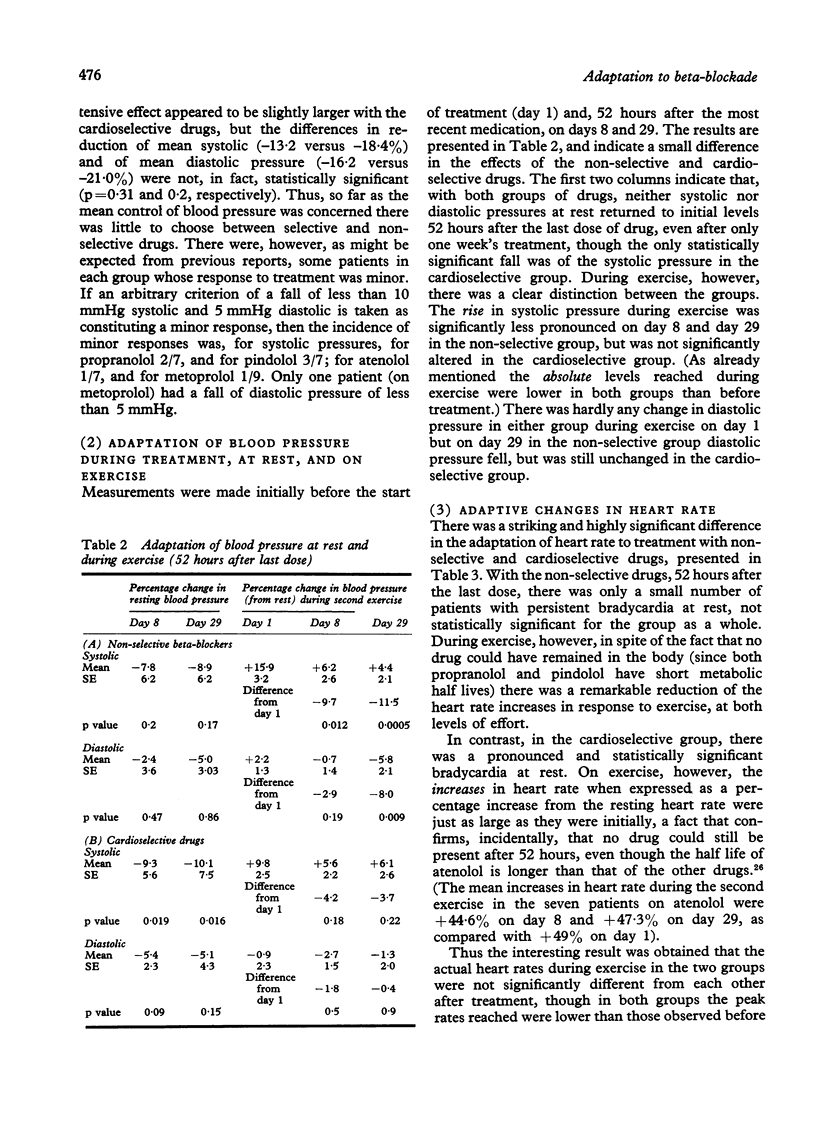
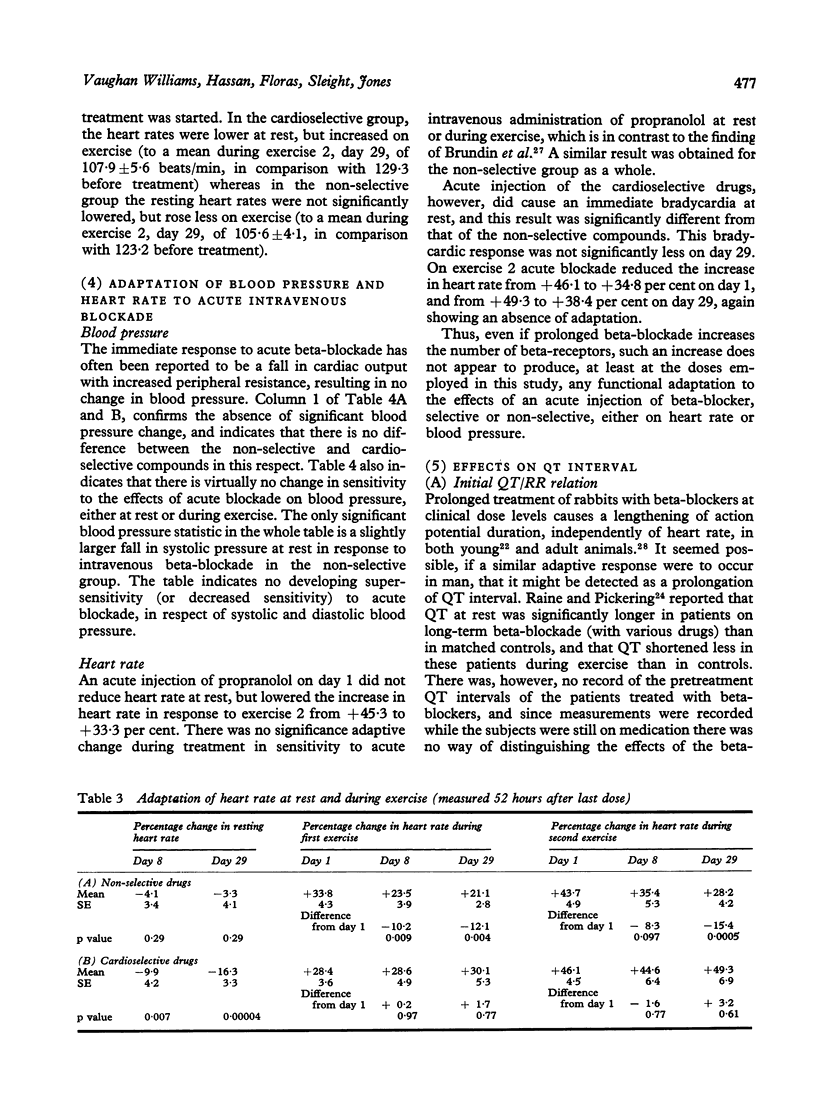
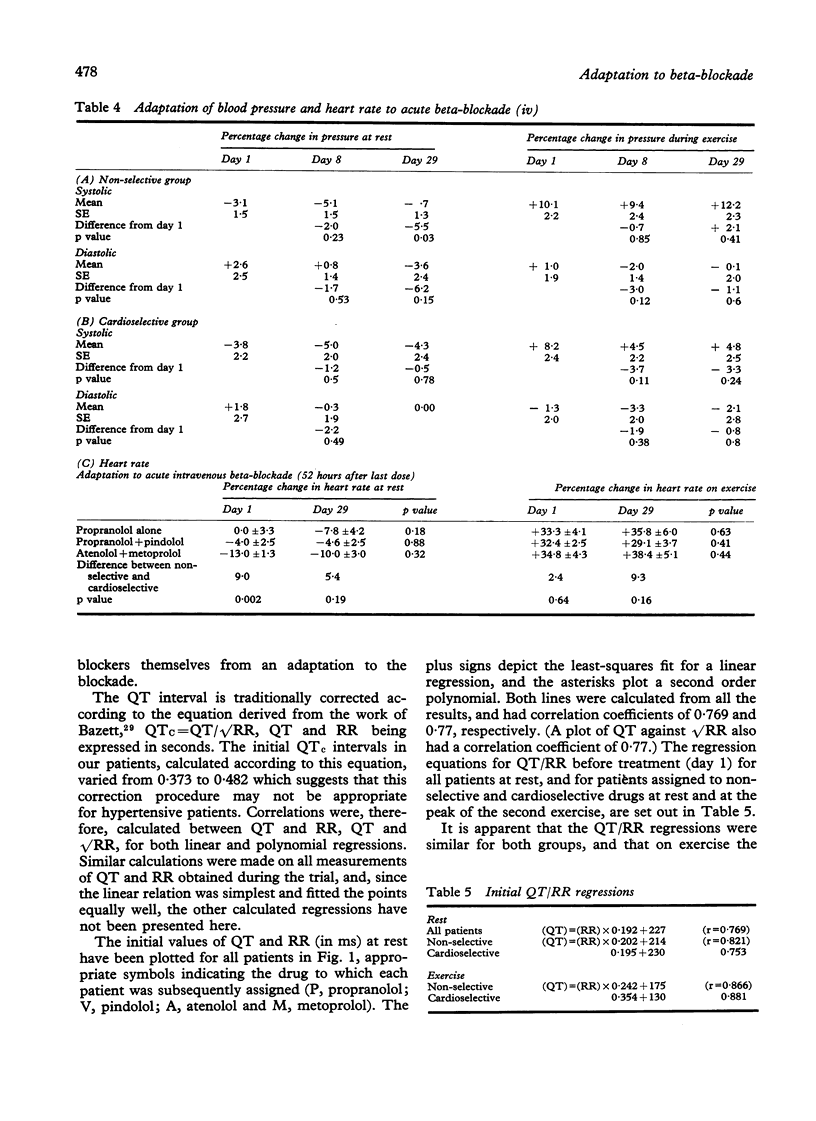
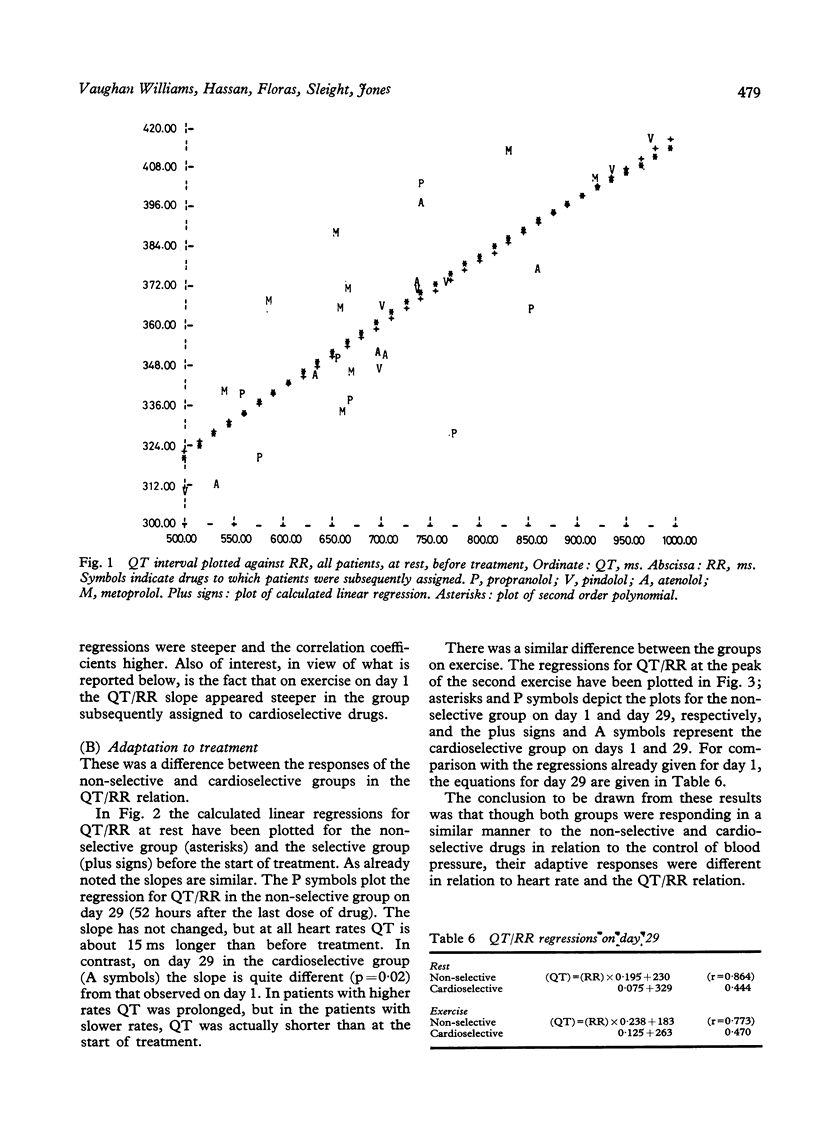
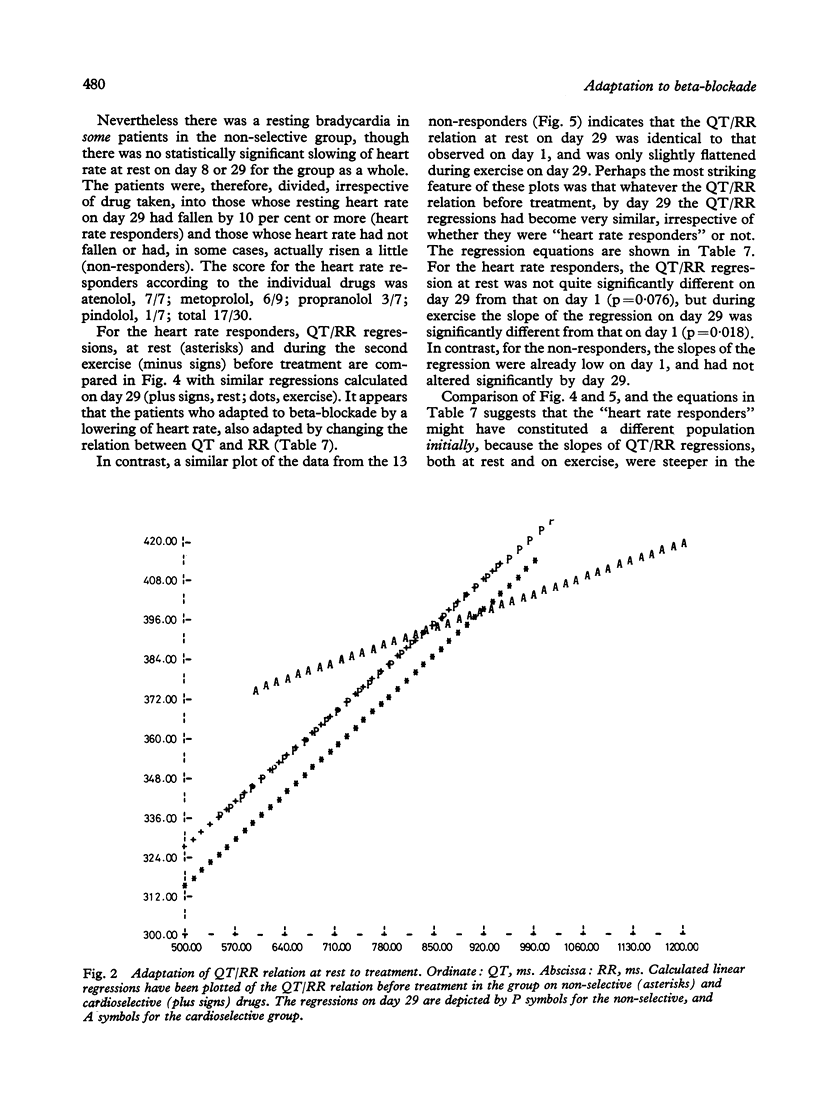
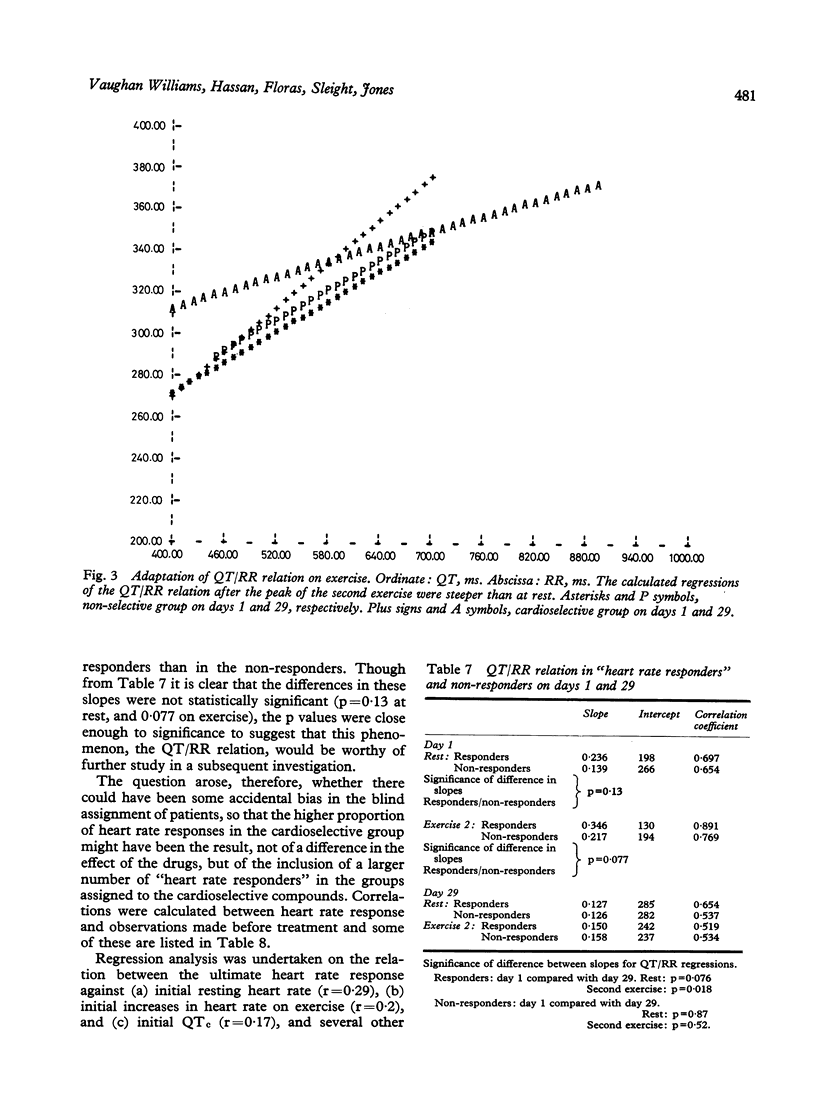
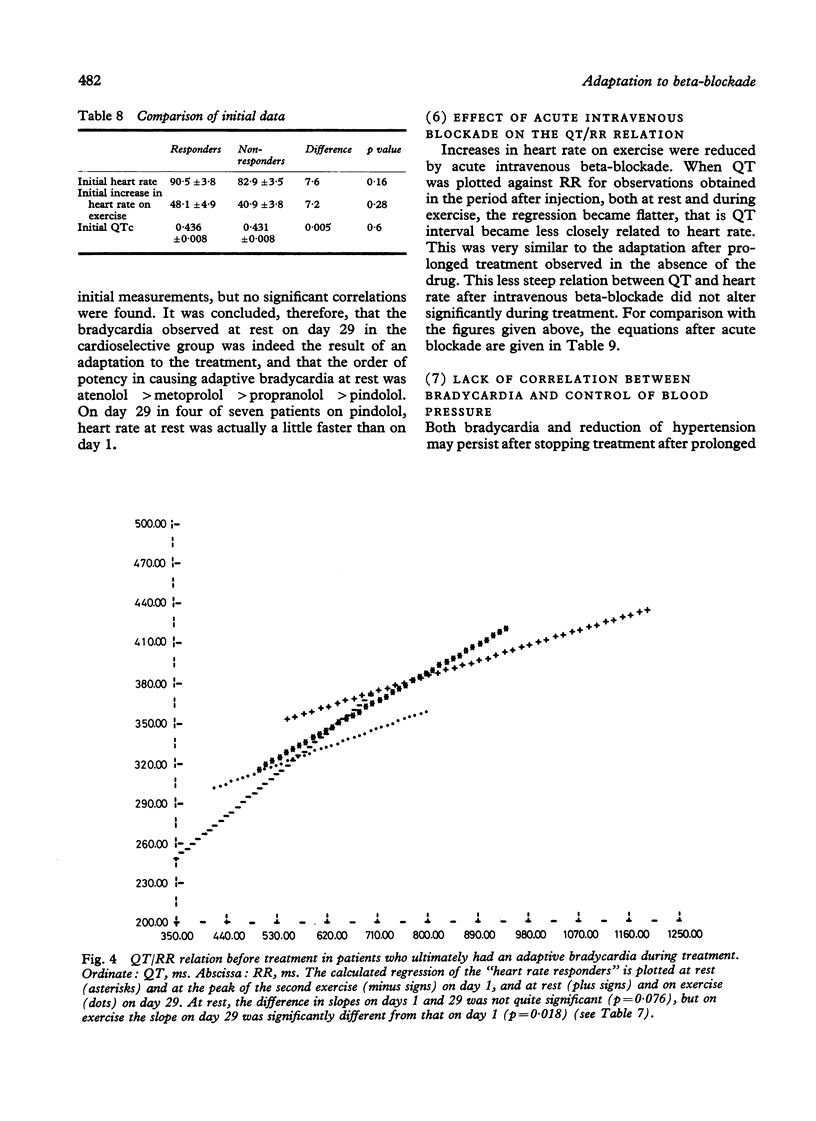
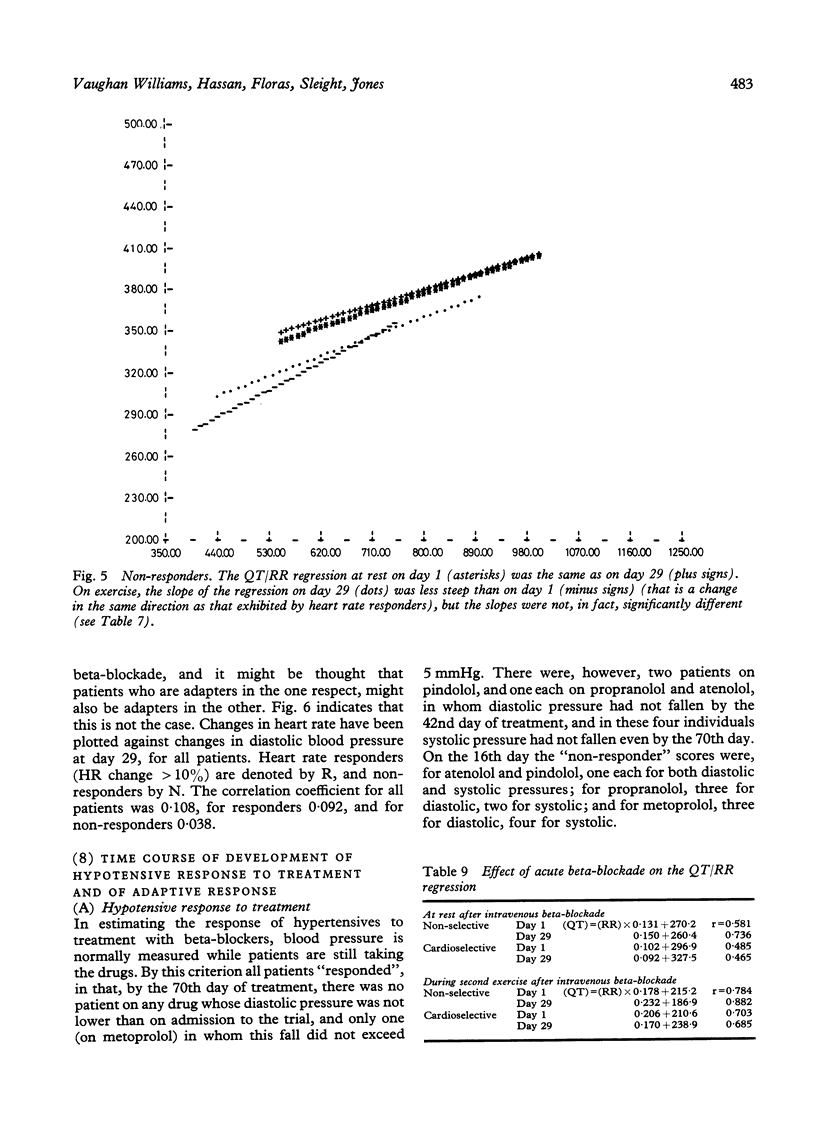
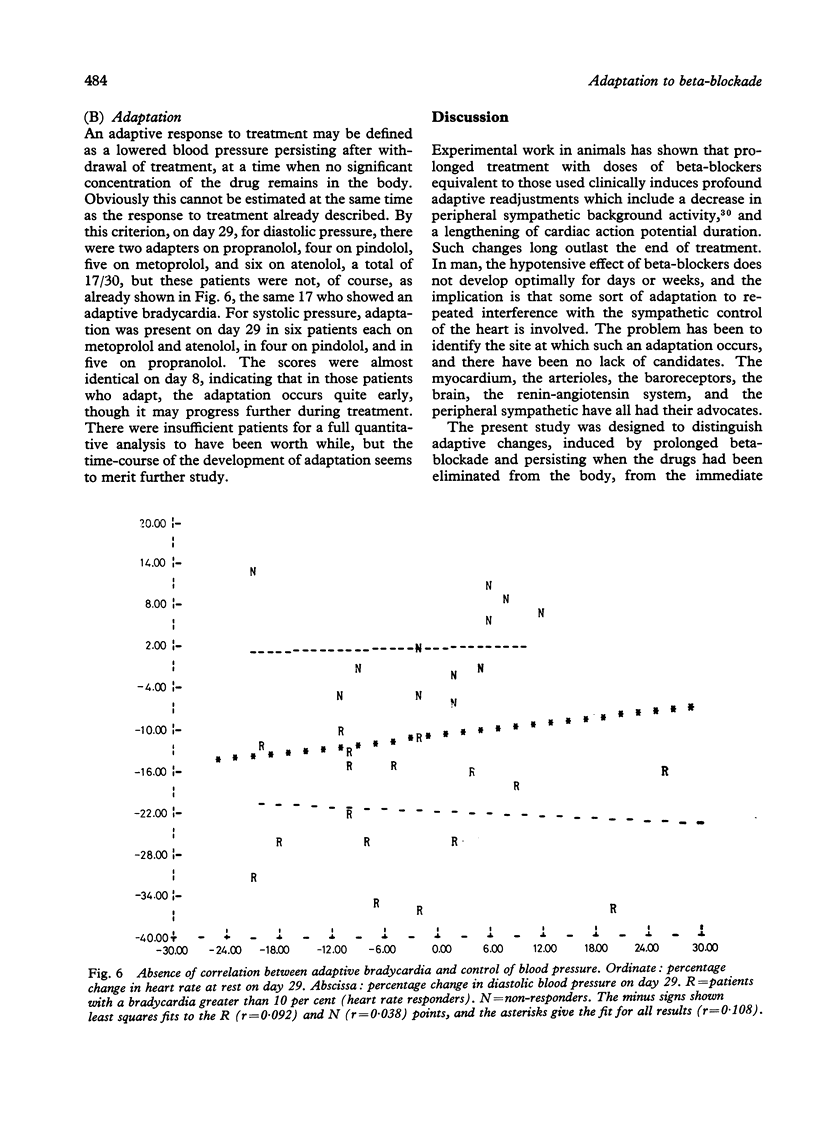
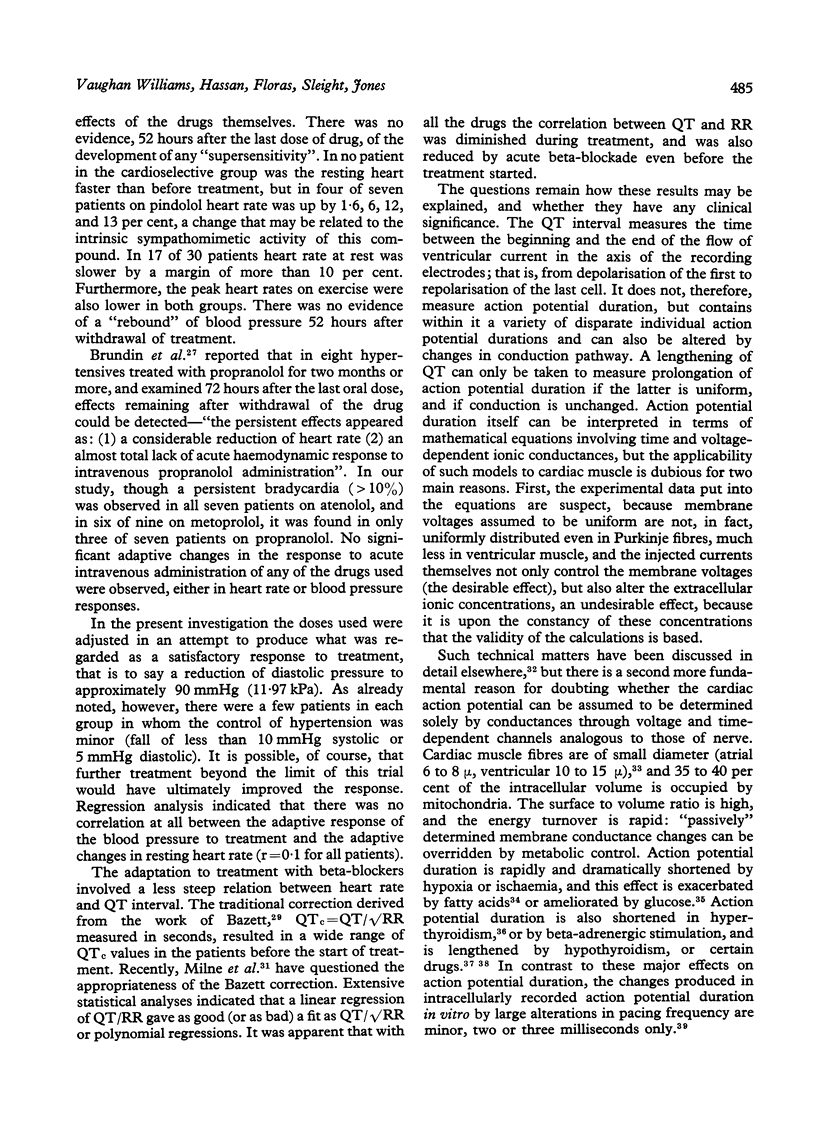
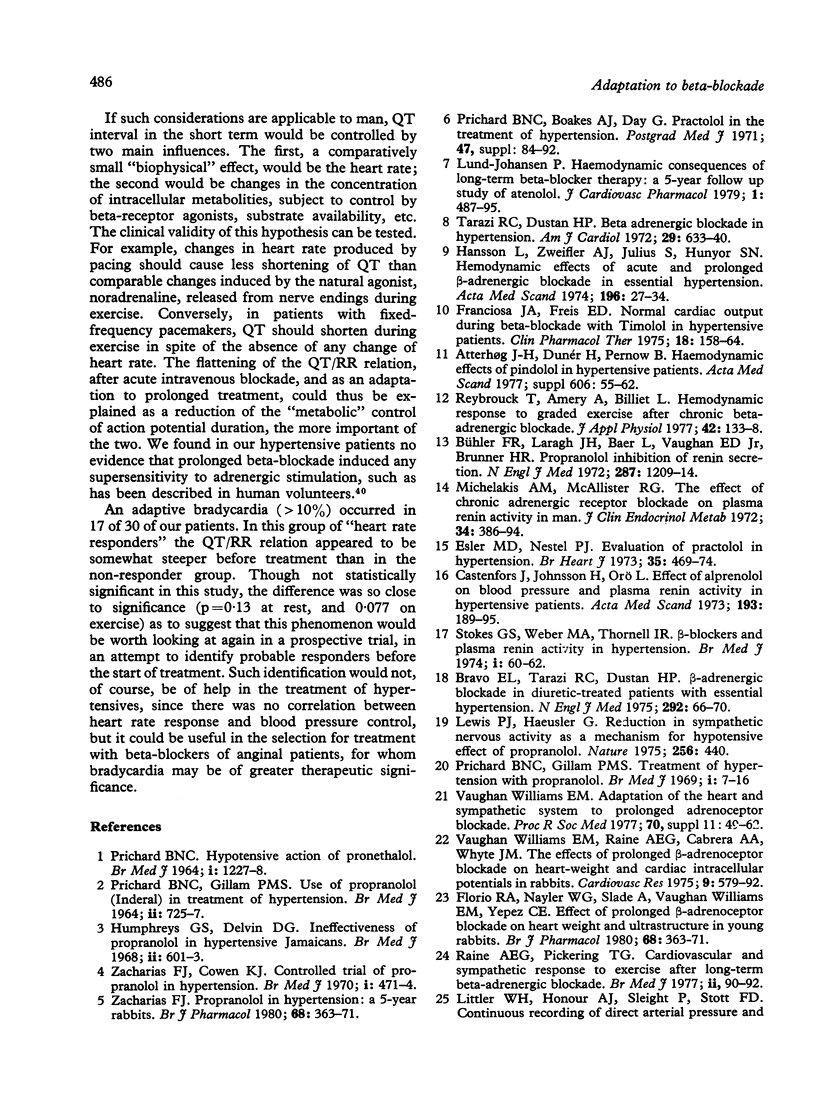
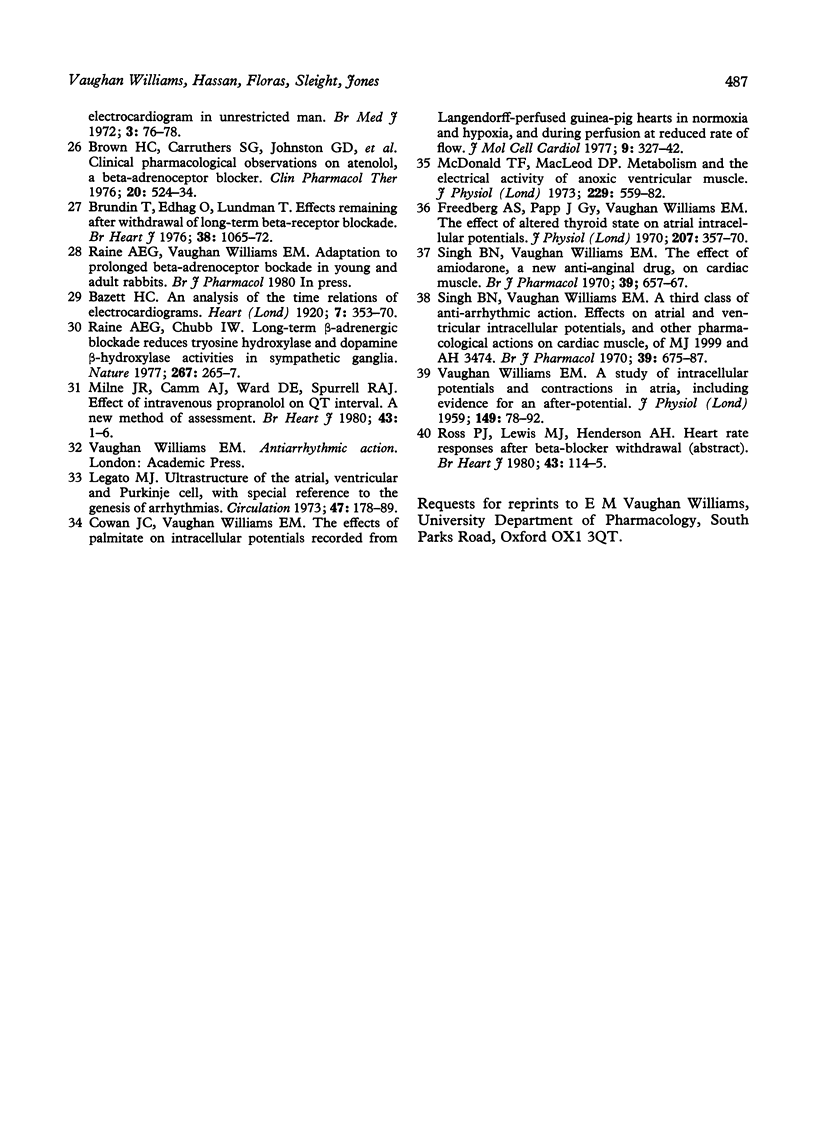
Selected References
These references are in PubMed. This may not be the complete list of references from this article.
- Atterhög J. H., Dunér H., Pernow B. Haemodynamic effects of pindolol in hypertensive patients. Acta Med Scand Suppl. 1977;606:55–62. doi: 10.1111/j.0954-6820.1977.tb18030.x. [DOI] [PubMed] [Google Scholar]
- Bravo E. L., Tarazi R. C., Dustan H. P. Beta-adrenergic blockade in diuretic-treated patients with essential hypertension. N Engl J Med. 1975 Jan 9;292(2):66–70. doi: 10.1056/NEJM197501092920203. [DOI] [PubMed] [Google Scholar]
- Brown H. C., Carruthers S. G., Johnston G. D., Kelly J. G., McAinsh J., McDevitt D. G., Shanks R. G. Clinical pharmacologic observations on atenolol, a beta-adrenoceptor blocker. Clin Pharmacol Ther. 1976 Nov;20(5):524–534. doi: 10.1002/cpt1976205524. [DOI] [PubMed] [Google Scholar]
- Brundin T., Edhag O., Lundman T. Effects remaining after withdrawal of long-term beta-receptor blockade. Reduced heart rate and altered haemodynamic response to acute propranolol administration. Br Heart J. 1976 Oct;38(10):1065–1072. doi: 10.1136/hrt.38.10.1065. [DOI] [PMC free article] [PubMed] [Google Scholar]
- Bühler F. R., Laragh J. H., Baer L., Vaughan E. D., Jr, Brunner H. R. Propranolol inhibition of renin secretion. A specific approach to diagnosis and treatment of renin-dependent hypertensive diseases. N Engl J Med. 1972 Dec 14;287(24):1209–1214. doi: 10.1056/NEJM197212142872401. [DOI] [PubMed] [Google Scholar]
- Castenfors J., Johnsson H., Orö L. Effect of alprenolol on blood pressure and plasma renin activity in hypertensive patients. Acta Med Scand. 1973 Mar;193(3):189–195. doi: 10.1111/j.0954-6820.1973.tb10560.x. [DOI] [PubMed] [Google Scholar]
- Cowan J. C., Vaughan Williams E. M. The effects of palmitate on intracellular potentials recorded from Langendorff-erfused guinea-pig hearts in normoxia and hypoxia, and during perfusion at reduced rate of flow. J Mol Cell Cardiol. 1977 Apr;9(4):327–342. doi: 10.1016/s0022-2828(77)80038-2. [DOI] [PubMed] [Google Scholar]
- Esler M. D., Nestel P. J. Evaluation of practolol in hypertension. Effects on sympathetic nervous system and renin responsiveness. Br Heart J. 1973 May;35(5):469–474. doi: 10.1136/hrt.35.5.469. [DOI] [PMC free article] [PubMed] [Google Scholar]
- Franciosa J. A., Freis E. D. Normal cardiac output during beta blockade with timolol in hypertensive patients. Clin Pharmacol Ther. 1975 Aug;18(2):158–164. doi: 10.1002/cpt1975182158. [DOI] [PubMed] [Google Scholar]
- Freedberg A. S., Papp J. G., Williams E. M. The effect of altered thyroid state on atrial intracellular potentials. J Physiol. 1970 Apr;207(2):357–369. doi: 10.1113/jphysiol.1970.sp009066. [DOI] [PMC free article] [PubMed] [Google Scholar]
- Hansson L., Zweifler A. J., Julius S., Hunyor S. N. Hemodynamic effects of acute and prolonged beta-adrenergic blockade in essential hypertension. Acta Med Scand. 1974 Jul-Aug;196(1-2):27–34. doi: 10.1111/j.0954-6820.1974.tb00962.x. [DOI] [PubMed] [Google Scholar]
- Humphreys G. S., Delvin D. G. Ineffectiveness of propranolol in hypertensive Jamaicans. Br Med J. 1968 Jun 8;2(5605):601–603. doi: 10.1136/bmj.2.5605.601. [DOI] [PMC free article] [PubMed] [Google Scholar]
- Legato M. J. Ultrastructure of the atrial, ventricular, and Purkinje cell, with special reference to the genesis of arrhythmias. Circulation. 1973 Jan;47(1):178–189. doi: 10.1161/01.cir.47.1.178. [DOI] [PubMed] [Google Scholar]
- Lewis P. J., Haeusler G. Reduction in sympathetic nervous activity as a mechanism for hypotensive effect of propranolol. Nature. 1975 Jul 31;256(5516):440–440. doi: 10.1038/256440a0. [DOI] [PubMed] [Google Scholar]
- Littler W. A., Honour A. J., Sleight P., Stott F. D. Continuous recording of direct arterial pressure and electrocardiogram in unrestricted man. Br Med J. 1972 Jul 8;3(5818):76–78. doi: 10.1136/bmj.3.5818.76. [DOI] [PMC free article] [PubMed] [Google Scholar]
- Lund-Johansen P. Hemodynamic consequences of long-term beta-blocker therapy: a 5-year follow-up study of atenolol. J Cardiovasc Pharmacol. 1979 Sep-Oct;1(5):487–495. doi: 10.1097/00005344-197909000-00001. [DOI] [PubMed] [Google Scholar]
- McDonald T. F., MacLeod D. P. Metabolism and the electrical activity of anoxic ventricular muscle. J Physiol. 1973 Mar;229(3):559–582. doi: 10.1113/jphysiol.1973.sp010154. [DOI] [PMC free article] [PubMed] [Google Scholar]
- Michelakis A. M., McAllister R. G. The effect of chronic adrenergic receptor blockade on plasma renin activity in man. J Clin Endocrinol Metab. 1972 Feb;34(2):386–394. doi: 10.1210/jcem-34-2-386. [DOI] [PubMed] [Google Scholar]
- Milne J. R., Camm A. J., Ward D. E., Spurrell R. A. Effect of intravenous propranolol on QT interval. A new method of assessment. Br Heart J. 1980 Jan;43(1):1–6. doi: 10.1136/hrt.43.1.1. [DOI] [PMC free article] [PubMed] [Google Scholar]
- Nayler W. G., Slade A., Vaughan Williams E. M., Yepez C. E. Effect of prolonged beta-adrenoceptor blockade on heart weight and ultrastructure in young rabbits. Br J Pharmacol. 1980 Mar;68(3):363–371. doi: 10.1111/j.1476-5381.1980.tb14549.x. [DOI] [PMC free article] [PubMed] [Google Scholar]
- Nayler W. G., Slade A., Vaughan Williams E. M., Yepez C. E. Effect of prolonged beta-adrenoceptor blockade on heart weight and ultrastructure in young rabbits. Br J Pharmacol. 1980 Mar;68(3):363–371. doi: 10.1111/j.1476-5381.1980.tb14549.x. [DOI] [PMC free article] [PubMed] [Google Scholar]
- PRICHARD B. N., GILLAM P. M. USE OF PROPRANOLOL (INDERAL) IN TREATMENT OF HYPERTENSION. Br Med J. 1964 Sep 19;2(5411):725–727. doi: 10.1136/bmj.2.5411.725. [DOI] [PMC free article] [PubMed] [Google Scholar]
- PRICHARD B. N. HYPOTENSIVE ACTION OF PRONETHALOL. Br Med J. 1964 May 9;1(5392):1227–1228. doi: 10.1136/bmj.1.5392.1227. [DOI] [PMC free article] [PubMed] [Google Scholar]
- Prichard B. N., Gillam P. M. Treatment of hypertension with propranolol. Br Med J. 1969 Jan 4;1(5635):7–16. doi: 10.1136/bmj.1.5635.7. [DOI] [PMC free article] [PubMed] [Google Scholar]
- Raine A. E., Chubb I. W. Long term beta-adrenergic blockade reduces tyrosine hydroxylase and dopamine beta-hydroxylase activities in sympathetic ganglia. Nature. 1977 May 19;267(5608):265–267. doi: 10.1038/267265a0. [DOI] [PubMed] [Google Scholar]
- Raine A. E., Pickering T. G. Cardiovascular and sympathetic response to exercise after long-term beta-adrenergic blockade. Br Med J. 1977 Jul 9;2(6079):90–92. doi: 10.1136/bmj.2.6079.90. [DOI] [PMC free article] [PubMed] [Google Scholar]
- Reybrouck T., Amery A., Billiet L. Hemodynamic response to graded exercise after chronic beta-adrenergic blockade. J Appl Physiol Respir Environ Exerc Physiol. 1977 Feb;42(2):133–138. doi: 10.1152/jappl.1977.42.2.133. [DOI] [PubMed] [Google Scholar]
- Singh B. N., Vaughan Williams E. M. A third class of anti-arrhythmic action. Effects on atrial and ventricular intracellular potentials, and other pharmacological actions on cardiac muscle, of MJ 1999 and AH 3474. Br J Pharmacol. 1970 Aug;39(4):675–687. doi: 10.1111/j.1476-5381.1970.tb09893.x. [DOI] [PMC free article] [PubMed] [Google Scholar]
- Singh B. N., Vaughan Williams E. M. The effect of amiodarone, a new anti-anginal drug, on cardiac muscle. Br J Pharmacol. 1970 Aug;39(4):657–667. doi: 10.1111/j.1476-5381.1970.tb09891.x. [DOI] [PMC free article] [PubMed] [Google Scholar]
- Stokes G. S., Weber M. A., Thornell I. R. Beta-blockers and plasma renin activity in hypertension. Br Med J. 1974 Jan 12;1(5897):60–62. doi: 10.1136/bmj.1.5897.60. [DOI] [PMC free article] [PubMed] [Google Scholar]
- Tarazi R. C., Dustan H. P. Beta adrenergic blockade in hypertension. Practical and theoretical implications of long-term hemodynamic variations. Am J Cardiol. 1972 May;29(5):633–640. doi: 10.1016/0002-9149(72)90164-6. [DOI] [PubMed] [Google Scholar]
- VAUGHAN WILLIAMS E. M. A study of intracellular potentials and contractions in atria, including evidence for an after-potential. J Physiol. 1959 Dec;149:78–92. doi: 10.1113/jphysiol.1959.sp006326. [DOI] [PMC free article] [PubMed] [Google Scholar]
- Williams E. M., Raine A. E., Cabrera A. A., Whyte J. M. The effects of prolonged beta-adrenoceptor blockade on heart weight and cardiac intracellular potentials in rabbits. Cardiovasc Res. 1975 Sep;9(5):579–592. doi: 10.1093/cvr/9.5.579. [DOI] [PubMed] [Google Scholar]
- Zacharias F. J., Cowen K. J. Controlled trial of propranolol in hypertension. Br Med J. 1970 Feb 21;1(5694):471–474. doi: 10.1136/bmj.1.5694.471. [DOI] [PMC free article] [PubMed] [Google Scholar]


